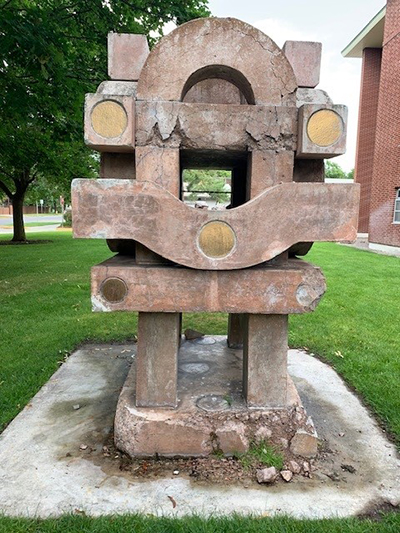Public Sculpture by Noted UM Art Professor to be Recreated for New Museum
MISSOULA – Call it a tale of two sculptures.
One is easily the most photographed work in the state of Montana, a backdrop for countless graduation photos, a meeting spot for midday walks, a jungle gym for adventurous youngsters.
The other, grand in its own design but constructed of a cement not made to last, is today no longer on display, housed and crumbling in a plywood crate, safe from the elements.
Both were the work of venerated artist Rudy Autio, for many years head of ceramics at UM, a professor emeritus and one of the country’s preeminent ceramicists.
His “Grizzly Bear” sculpture, of course, has been an iconic piece of UM’s campus since its installation in 1969 – part of treasured lore for generations of students and alumni.
His sculpture “Signal,” conversely, has been shuttled from location to location across campus and buried in Autio’s illustrious portfolio of work – until now.

For more than five years, Autio’s daughter Lisa and the artist’s longtime friend and co-creator Hugh Warford have worked with Montana Museum of Art and Culture Director Rafael Chacón to determine a better future for the sculpture, put to storage in 2019.
“We knew it couldn’t be repaired again,” Chacón said. “So the question became how do we bring back a significant piece of public sculpture without necessarily rebuilding it. We decided we’d do what Rudy originally wanted to do and that was to create ‘Signal’ in metal.”
The three are now collecting donations to build “Signal” anew and have commissioned UM grad Nick Chaussee build it. So far they’ve tallied about one-third of the needed $60,000 to build the sculpture, which will eventually anchor the outside plaza of the new MMAC building, scheduled to open during Homecoming this fall.
Lisa Autio, who maintains Autio’s website, has spent the past several years monitoring the health of his public works, commissioned by clients as far ranging as churches and banks. She said it’s what you do when your parent is a noted artist and you want to preserve his creations, including “Signal.” Rudy Autio died in 2007.
“After 50 years, people lose track of who the artist was,” said Lisa Autio, who’s been known to check in on works as she travels across the region. “I like to make sure they are in a good condition for the next 50.”
Warford, who first met Rudy Autio while working as his studio assistant in the ’60s, said the artist chose concrete for the sculpture’s first iteration because it was all he could afford. The material, though, was scoria concrete, which Warford explained is soft and prone to deterioration.
“It was built in 1966, but by 1974 it was already degrading,” said Warford, who went on to earn a Bachelor of Fine Arts from UM and Master of Fine Arts from Arizona State University. “I repaired some of it in the late ’80s, and those sections are holding up, but the rest is in bad condition.”
“Signal” harkens to Autio’s deep interest in the Mingei tradition of Japan, which celebrates hand-made folk-crafts created for ordinary uses, Chacón explains.
“It’s a unique architectonic work about the principles of balance and harmony stemming from Rudy’s study of Japanese architecture and animism, which sees the elements themselves as spiritual forces,” he said. “I see a lot of temple and gateway architecture in that design, fitting for the entry to the new museum.”
Earlier versions of the work – models of a sort – exist in MMAC’s current collection and with the family, Warford said, and typify the sometimes-circular thread that Autio’s designs would take.
“Rudy always came back to stuff; he never let ideas go,” Warford said. “He was definitely playing with this idea of ‘Signal’ in a number of different models.”
Once all the funding is raised, it will take six months to fabricate “Signal,” and when complete it will stand almost 9 feet tall and 6 feet wide. Warford said the hope is Autio’s children will participate in the construction to honor their father’s legacy. There are no definitive ideas about what to do with the existing sculpture except perhaps save some of the ceramic medallions embedded in its sides.
Ultimately the new “Signal” will be the first of many sculptures in MMAC’s plaza, Chacón said.
“Our hope is that additional works will come from other artists, certainly from students and faculty,” he said. “We want to build and add to the public art tradition in Missoula and the campus.”
Lisa Autio and Warford said Rudy Autio and his wife, artist Lela Autio, would be honored to see “Signal” rebuilt and in place – a sculpture of note complementing his better-known work across campus.
“I think the public interaction with this piece would be important to Rudy and to his legacy,” Warford said of his mentor. “And I think he would love nothing more than seeing kids interact with it. That would tickle him to death. It will tickle me to death.”
Editor's note: The new 17,000 square-foot MMAC building will open to the public in September. The privately funded project is made possible by the generosity of many donors, including a contribution of $12.5 million from longtime UM donors Patt and Terry Payne.
###
Contact: H. Rafael Chacón, Suzanne and Bruce Crocker Director of the MMAC, 406-243-2019, rafael.chacon@mso.umt.edu.